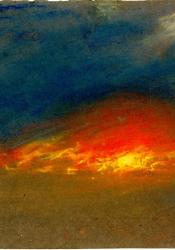Krakatoa Eruption of 1883
Krakatoa, also called Krakatau, is an Indonesian island best-known for being the site of one of the deadliest volcanic eruptions in recorded history. In late August of 1883, after a few months of minor eruptions and substantial volcanic activity, Krakatoa blew its top in a spectacular and frightening display that destroyed two-thirds of the island. The ash began to fall on August 25, and two days later, four consecutive explosions sent tsunamis careening into the shores of Sumatra and Java, killing over 36,000 people. In addition, the third and most powerful explosion generated a sonic pressure wave that was heard 3,000 miles away, making it “the furthest-travelling audible sound in recorded history” (Thornton 1); the resulting air wave registered on barographs worldwide and was determined to have crossed the globe seven times (Symons 63).
Effects
The eruption of Krakatoa was one of the earliest examples of breaking international news, and it highlighted the capabilities of telegraphic communication as word of the event spread like wildfire. Carefully-documented local observations, both from Indonesia and around the world, provided invaluable data in examining the power, ash spread, and aftereffects of the eruption, and that marriage of informal with academic renewed public interest in scientific research. Krakatoa itself quickly became a centerpoint for much of that research; no life on the island survived the eruption, which provided scientists with a unique opportunity to witness ecological rebirth in the wake of such a catastrophic disaster. Furthermore, fumes released by the eruption into the atmosphere dropped global temperatures and led to record-high rainfall along the West Coast of North America. Ash blown skyward spread across the world via air currents, causing breathtaking – and occasionally alarming – sunsets across the world, some of which were captured by various artists, including William Ascroft. In fact, some researchers believe Edvard Munch’s famous painting The Scream features a sunset derived from Munch’s memory of a Krakatoa sunset (Olson 3).
Morgan, Monique R. “The Eruption of Krakatoa (also known as Krakatau) in 1883.” BRANCH: Britain, Representation and Nineteenth-Century History. Ed. Dino Franco Felluga. Extension of Romanticism and Victorianism on the Net. Web. 6 November 2020.
Thornton, Ian. Krakatau: The Destruction and Reassembly of an Island Ecosystem. Cambridge: Harvard UP, 1996. Print.
Symons, G. J., ed. The Eruption of Krakatoa, and Subsequent Phenomena: Report of the Krakatoa Committee of the Royal Society. London: Trübner, 1888. Google Books. Web. 6 November 2020.
Olson, Donald W.; Russell L. Doescher; Marilynn S. Olson (May 2005). "The Blood-Red Sky of the Scream". APS News. American Physical Society. Retrieved 6 November 2020.

